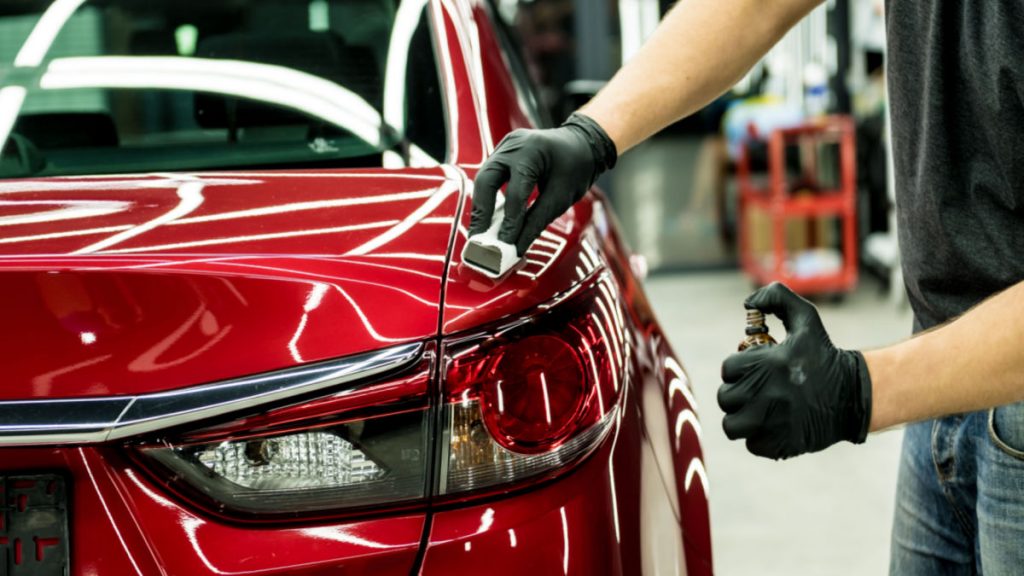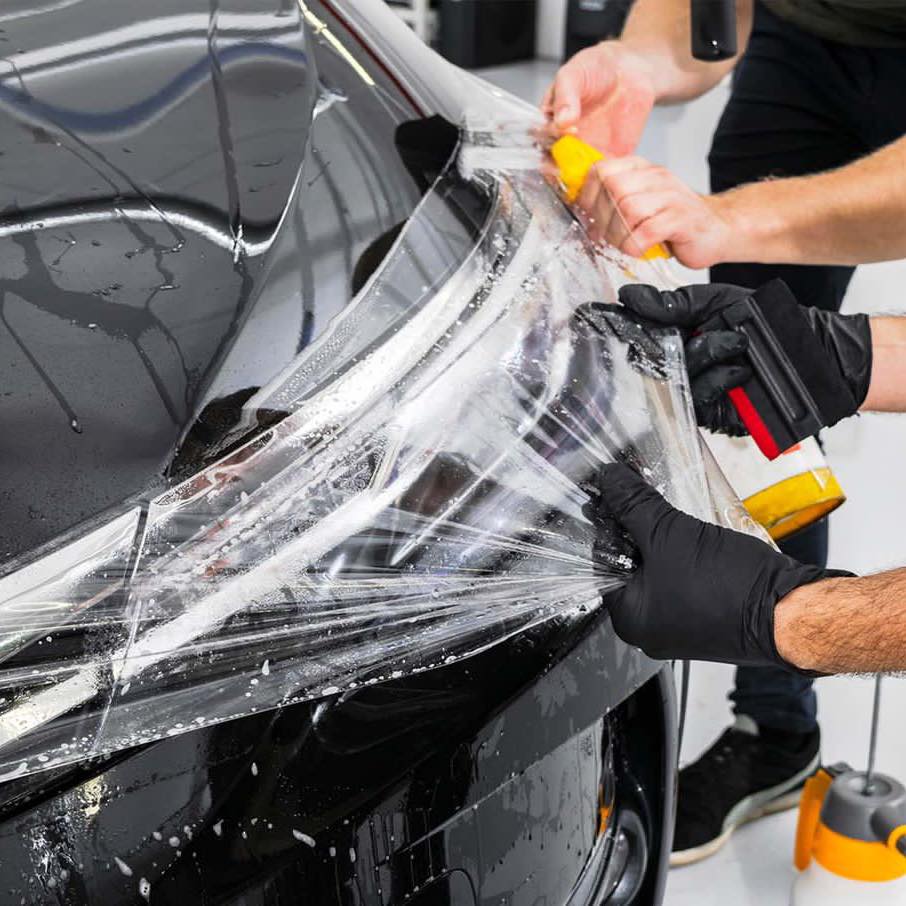PPF vs Ceramic Coating: A Comprehensive Comparison
Protecting your vehicle’s paint is crucial in maintaining its aesthetic appeal and resale value. Two popular options that stand out in the market today are Ceramic Coating and Paint Protection Film (PPF). But what sets them apart? This article delves into the differences between these two options, helping you make an informed decision.
What is Ceramic Coating?
Ceramic coating is a liquid polymer that, when applied, bonds with your vehicle’s paint and forms a protective layer. It’s a popular choice among car enthusiasts for several reasons:
- Durability: Ceramic coatings are known for their durability. They are resistant to many common sources of wear and tear like dirt, chemicals, UV rays, and minor scratches.
- Glossy Finish: If you’re after that high-gloss, wet look on your car, ceramic coatings can deliver. They enhance the color and depth of your car’s paint, giving it a stunning finish.
- Ease of Cleaning: Dirt and grime find it harder to stick to surfaces coated with ceramic. This means your car stays cleaner for longer and will require less effort to wash.
However, while ceramic coatings excel in these areas, they are less effective against physical impacts like heavy scratches or chips from rocks.
The Power of Paint Protection Film (PPF)
PPF, on the other hand, is a thick, clear film applied to your car’s surface. It offers several benefits:
- Physical Damage Protection: PPF excels in protecting against physical damage. It can guard against scratches, rock chips, and swirl marks, which ceramic coatings may not prevent.
- Self-Healing Properties: One of the unique features of PPF is its ability to self-heal minor scratches. When exposed to heat, the film can smooth out damage, keeping your car looking pristine.
- Stain Resistance: PPF is resistant to stains and oxidation, helping to keep your car’s paint looking fresh and vibrant.
Ceramic Coating vs PPF: The Showdown
While both ceramic coatings and PPF offer protection, their strengths lie in different areas.
Ceramic coating shines in its longevity and the glossy finish it imparts. It’s also hydrophobic, meaning water will bead on the surface and slide off, making your car easier to clean. However, it’s not as effective against physical impacts.
PPF, however, is the go-to for robust protection against physical damage. Its self-healing properties are a significant advantage, especially for those who frequently drive in conditions where scratches and chips are common.
Making the Right Choice
In conclusion, the choice between ceramic coating and PPF depends on your specific needs and the conditions your vehicle is exposed to.
If you’re after a long-lasting, easy-to-clean solution with a glossy finish, ceramic coating is your best bet. But if you’re looking for robust protection against physical damage, PPF is the way to go.
Remember, protecting your vehicle’s paint is an investment in maintaining its look and value. Whether you choose ceramic coating or PPF, both will serve to preserve your vehicle’s aesthetic appeal and integrity.
Note: Always consult with a professional before making a decision on paint protection for your vehicle.
Types of Paint Protection Film (PPF)
PPF is a great way to protect your vehicle’s paint from damage. There are several types of PPF available in the market, each with its own unique features:
1. Clear Paint Protection Film (PPF)
This is the most common type of PPF. It’s transparent, allowing your vehicle’s paint color to show through while providing a layer of protection against scratches, chips, and UV rays.
2. Matte Paint Protection Film
Matte PPF gives your vehicle a sleek, modern look with its non-glossy finish. It offers the same level of protection as clear PPF but adds a unique aesthetic to your vehicle.
3. Colored Paint Protection Film (PPF)
Colored PPF allows you to change the color of your vehicle while providing protection. It’s available in a variety of colors, so you can customize your vehicle’s look to your liking.
4. Self-Healing Paint Protection Film
Self-healing PPF has the ability to repair itself from minor scratches. When exposed to heat, the film “heals” by returning to its original shape, making scratches disappear.
5. Ceramic Pro PPF
Ceramic Pro PPF is a combination of PPF and ceramic coating. It offers the benefits of both, providing superior protection against physical damage and a glossy finish.
Exploring the Different Types of Ceramic Coating
Ceramic coating is a popular choice for car enthusiasts looking to protect their vehicle’s paint while enhancing its appearance. But did you know there are different types of ceramic coatings? Let’s delve into the various options available:
1. Nano Ceramic Coating
Nano ceramic coating is a liquid polymer that chemically bonds with your vehicle’s paint, creating a layer of protection. It’s known for its superior durability, high gloss finish, and hydrophobic properties. This type of coating can last for several years with proper maintenance.
2. Hybrid Ceramic Coating
Hybrid ceramic coating combines the benefits of traditional wax with the long-lasting protection of ceramic coating. It’s easier to apply than nano ceramic coating and offers a glossy finish and good hydrophobic properties. However, it doesn’t last as long as nano ceramic coating.
3. Ceramic Spray Coating
Ceramic spray coating is a user-friendly product that’s perfect for DIY enthusiasts. It’s easy to apply and provides a nice shine and decent protection against UV rays and light scratches. However, it’s less durable than other types of ceramic coatings and needs to be reapplied more frequently.
4. Ceramic Coating for Wheels
Ceramic coating for wheels is specially formulated to withstand the harsh conditions that wheels are exposed to, such as high temperatures and brake dust. It provides a protective barrier that makes wheels easier to clean and maintain.
5. Ceramic Coating for Glass
Ceramic coating for glass enhances visibility during rainy conditions due to its excellent hydrophobic properties. It repels water, causing it to bead up and roll off the glass, improving safety while driving in the rain.
Related Read :
JPJ Approved Car Tinting Rules in Malaysia
Motor Trader Car Care and Maintenance Tips
Popular Pages:
Second hand car for sales in Malaysia
Special number plate for sales in Malaysia
Submitting your news to Motortrader.com.my is easy. Simply send an email to [email protected] with your press release or announcement attached as a Word or PDF document. Please include your contact information and any relevant images or videos that you would like to accompany your news.


